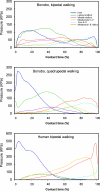Locomotion in bonobos (Pan paniscus): differences and similarities between bipedal and quadrupedal terrestrial walking, and a comparison with other locomotor modes
- PMID: 15198700
- PMCID: PMC1571309
- DOI: 10.1111/j.0021-8782.2004.00292.x
Locomotion in bonobos (Pan paniscus): differences and similarities between bipedal and quadrupedal terrestrial walking, and a comparison with other locomotor modes
Abstract
One of the great ongoing debates in palaeo-anthropology is when, and how, hominids acquired habitual bipedal locomotion. The newly adopted bipedal gait and the ancestral quadrupedal gait are most often considered as very distinct, with each habitual locomotor mode showing corresponding anatomical adaptations. Bonobos (Pan paniscus), along with common chimpanzees (P. troglodytes), are the closest living relatives to humans and their locomotion is valuable for comparison with other primates, and to gain an insight in the acquisition of human bipedalism. Bonobos are habitual quadrupeds, but they also engage in bipedal locomotion, both on terrestrial and in arboreal substrates. In terms of kinematics and dynamics, the contrast between bipedal and quadrupedal walking seems to be more subtle than one might expect. Apart from the trunk being approximately 37 degrees more erect during bipedal locomotion, the leg movements are rather similar. Apart from the heel, plantar pressure distributions show subtle differences between bipedal and quadrupedal locomotion. Regardless, variability is high, and various intermediate forms of locomotion (e.g. tripedal walking) exist both in captivity and in the wild. Moreover, there is overlap between the characteristics of walking and other locomotor modes, as we show with new data of walking on an inclined pole and of vertical squat jumps. We suggest that there is great overlap between the many locomotor modes in bonobos, and that the required polyvalence is reflected in their anatomy. This may hamper the development of one highly specialized gait (i.e. bipedalism), which would constrain performance of the other types of locomotion.
Figures







Similar articles
-
Locomotor versatility in the white-handed gibbon (Hylobates lar): a spatiotemporal analysis of the bipedal, tripedal, and quadrupedal gaits.J Hum Evol. 2006 May;50(5):552-67. doi: 10.1016/j.jhevol.2005.12.011. Epub 2006 Mar 3. J Hum Evol. 2006. PMID: 16516949
-
Dynamic plantar pressure distribution during terrestrial locomotion of bonobos (Pan paniscus).Am J Phys Anthropol. 2003 Apr;120(4):373-83. doi: 10.1002/ajpa.10163. Am J Phys Anthropol. 2003. PMID: 12627532
-
Gait characteristics and spatio-temporal variables of climbing in bonobos (Pan paniscus).Am J Primatol. 2016 Nov;78(11):1165-1177. doi: 10.1002/ajp.22571. Epub 2016 Jun 16. Am J Primatol. 2016. PMID: 27309794
-
Insights into the evolution of human bipedalism from experimental studies of humans and other primates.J Exp Biol. 2003 May;206(Pt 9):1437-48. doi: 10.1242/jeb.00279. J Exp Biol. 2003. PMID: 12654883 Review.
-
Mechanisms for the acquisition of habitual bipedality: are there biomechanical reasons for the acquisition of upright bipedal posture?J Anat. 2004 May;204(5):363-84. doi: 10.1111/j.0021-8782.2004.00303.x. J Anat. 2004. PMID: 15198701 Free PMC article. Review.
Cited by
-
Central pattern generators for bipedal locomotion.J Math Biol. 2006 Sep;53(3):474-89. doi: 10.1007/s00285-006-0021-2. Epub 2006 Jul 28. J Math Biol. 2006. PMID: 16874500
-
Bipedal tool use strengthens chimpanzee hand preferences.J Hum Evol. 2010 Mar;58(3):234-41. doi: 10.1016/j.jhevol.2009.11.008. Epub 2010 Jan 20. J Hum Evol. 2010. PMID: 20089294 Free PMC article.
-
The human semicircular canals orientation is more similar to the bonobos than to the chimpanzees.PLoS One. 2014 Apr 7;9(4):e93824. doi: 10.1371/journal.pone.0093824. eCollection 2014. PLoS One. 2014. PMID: 24710502 Free PMC article.
-
Strategies for obstacle avoidance during walking in the cat.J Neurophysiol. 2017 Aug 1;118(2):817-831. doi: 10.1152/jn.00033.2017. Epub 2017 Mar 29. J Neurophysiol. 2017. PMID: 28356468 Free PMC article.
-
Human Locomotion in Hypogravity: From Basic Research to Clinical Applications.Front Physiol. 2017 Nov 7;8:893. doi: 10.3389/fphys.2017.00893. eCollection 2017. Front Physiol. 2017. PMID: 29163225 Free PMC article. Review.
References
-
- Aerts P, Van Damme R, Van Elsacker L, Duchêne V. Spatio-temporal gait characteristics of the hind-limb cycles during voluntary bipedal and quadrupedal walking in bonobos (Pan paniscus) Am. J. Phys. Anthropol. 2000;111:503–517. - PubMed
-
- Bauer HR. Chimpanzee bipedal locomotion in the Gombe National Park, East Africa. Primates. 1977;18:913–921.
-
- Benton MJ. Vertebrate Palaeontology. 2. London: Chapman & Hall; 1997.
-
- Boyd R, Silk JB. How Humans Evolved. 2. New York: W.W. Norton.; 2000.
Publication types
MeSH terms
LinkOut - more resources
Full Text Sources
Other Literature Sources
Medical

